How To Draw 1 4-dimethyl-1 Pentene
Stereochemistry
TABLE OF CONTENTS FOR THIS CHAPTER
- Isomers:Definitions
- Constitutional Isomers
- Stereoisomers
- Chirality
- Symmetry Elements
- Nomenclature for Enantiomers
- 2 Stereogenic Centers
- Ii Equivalent Stereogenic Centers
- Comparative Properties of Enantiomers/Diastereoisomers
- Optical Activity
- Racemic Mixtures
- Optical Purity
- Resolution of Enantiomers
- Kinetic Resolution
Isomers:Definitions
You lot are already familiar with the concept of isomers: different compounds which have the aforementioned molecular formula. In this chapter we learn to make distinctions between various kinds of isomers, especially the more subtle kind of isomers which we call stereoisomers.
- Constitutional Isomers: Isomers which differ in "connectivity". The latter term means that the difference is in the sequence in which atoms are attached to ane some other. Examples of isomers pairs which are consitutional isomers are (1)butane and methylpropane,i.e., isobutane, which are different in that butane has a sequence of four carbon atoms in a row, simply isobutane has a three carbon concatenation with a co-operative (two)dimethyl ether and ethanol--the old has a C-O-C chain, while the latter has a C-C-O concatenation (3) one-pentene and cyclopentane--the former has an acylic concatenation of 5 carbons, while the latter has a 5-membered ring.
- Stereoisomers: Isomers which accept the same connectivity. Thus all isomers are either ramble or stereoisomers. Stereoisomerism is a more subtle kind of isomerism in which the isomers differ only in their spatial arrangement, non in their connectivity. Cis- and Trans-1,4-dimethylcyclohexane are a skillful instance of a pair of stereoisomers.
Stereoisomers
We have simply seen that in that location are two major types of isomer, only now information technology is necessary to further notice that their are two sub-types of stereoisomers:
- Enantiomers: Stereoisomers which are mirror images
- Diastereoisomers: Stereoisomers which are non mirror images
The examples of cis- and trans-1,4-dimethylcyclohexane are of the latter type, that is , they are diastereoisomers. Cis- and trans-isomers in general are diastereoisomers. They have the aforementioned connectivity but are not mirror images of each other. Enantiomers are mirror image isomers. This is the very virtually subtle style in which 2 chemical compounds can differ:In an overal sense, so , there are three types of isomers: (1)constitutional isomers (2)diastereoisomers and (3)enantiomers in order of increasing subtlety of deviation. Since nosotros take previously considered constitutional isomerism, and since the difference between diastereoisomers and enantiomers rests upon the concept of mirror paradigm isomerism, we must now consider this latter phenomenon in greater detail.
Mirror Image Isomerism
To be isomers, molecules must non be identical. The examination for "identicality" is one of superimposability . In a sample of butane, all of the molecules are identical because they tin exist superimposed upon one another in some conformation. The same is true of ethanol or propanol or 1-butanol, but in the example of 2-butanol there are two isomeric forms which can non exist superimposed. They do not differ in connectivity, obviously, or they wouldn't both be chosen by the same name (2-butanol). They also don't have a cis or trans prefix, to point that they are diastereoisomers. They have a very specific, unique relationship to one some other, the same relationship which exists betwixt an object and its mirror image. A key aspect of this difference, as we all know, is that a mirror acts to interchange left and right hands.CHIRALITY
- A molecule or object which is not identical to(i.e., non-superimposable upon) its mirror image molecule or object is said to be chiral. This means it resembles a human paw in that the left and correct hands are non superimposabile but can be readily distinguished (at to the lowest degree past some of us). By the same token, a molecule or any object is said to be achiral if it is identical to (superimposable upon) its mirror image molecule or object. Many molecules are achiral, just many are chiral, particularly circuitous molecules such as are establish in biological systems.How tin can nosotros conceptualize when a molecule is chiral and therefore has an isomer (an enantiomer) or when it is achiral and has no enantiomer?
- Consider 2-butanol, which is an example of a chiral molecule. The analogy beneath (hopefully) shows that the mirror prototype of ane ii-butanol isomer is non-superimposable upon the original molecule. Your can verify this by making models, merely you can also visualize trying to superimpose the ii by sliding one structure over (mentally) on top of the other.We can, for example, slide B over to A and superimpose the OH, the key C, and its fastened H of the B molecule over the corresponding gorups of the A molecule, but the ethyl group on B sits over the methyl grouping of A, and the methyl grouping on B superimposes upon the ethyl group of A. The ii molecules have all the aforementioned kinds of bonds and are extremely like, merely are mirror paradigm isomers. We will learn how to name the two dissimilar enantiomers before long.
- Although ii-butanol is a chiral molecule and therefore has two enantiomers, the very like molecule 2-propanol is achiral and does non be equally an enantiomeric pair. In the analogy, you tin can come across that B slides over onto A with all respective groups superimposing perfectly. Many elementary molecules are of this kind. How can we predict whether a molecule is chiral or achiral?
- One of the elementary ways is to use the concept of a stereogenic center. If a molecule has a single stereogenic centre it will necessarily be chiral. The most common kind of stereogenic center is a carbon (or other atom) which has iv different atoms or groups directly fastened to it. You tin see that the central carbon of 2-butanol (the one marked by an asterisk) is a stereogenic middle, having H,OH,methyl, and ethyl groups attached. Since it has just a unmarried stereogenic center , it must be chiral. On the other hand, 2-propanol has no stereogenic center and is achiral. The corresponding carbon atom of 2-propanol has an OH,H, and two methyl groups fastened. Of course, no methyl carbon atom or methylene carbon tin be chiral since these groups automatically accept at least two identical groups (H's) attached. Nosotros will run across a little afterward what happens when we have more than than ane stereogenic center.
- The second method, specially useful when there is more than one stereogenic center, is the utilize of symmetry elements.If the molecule or object has either a airplane of symmetry or a center of symmetry information technology is achiral. The examples shown below refer to cis- and trans-1,2-dimethylcyclobutane, The former of which is achiral and the latter chiral. They both have ii stereogenic centers, viz., the ring carbons which have the methyl and hydrogen groups fastened, but 1 molecule is chiral and the other achiral. This emphasizes the betoken that a molecule or object is guaranteed to exist chiral only if it has a unmarried stereogenic center. If it has more than one stereogenic center, information technology may be either chiral or achiral. Note that in the cis isomer, the 2 methyls are on the same side of the ring and are equidistant from the plane of symmtery which runs through the center of the ring perpendicular to the ring. In the trans isomer, the methyls are on opposite sides of the band, and then that where there is a methyl group on the right there is a H on the left.
- What is the human relationship between the cis and trans isomers of one,2-dimethylcyclobutane??? They are diastereoisomers, having the same connectivity only manifestly not being mirror images of each other. To sum up, there are three isomers of ii,3-dimethylcyclobutane, a single cis isomer, and two enantiomeric trans isomers.
- The aeroplane of symmetry is relatively like shooting fish in a barrel to find and is the nearly common one to look for, simply i other element of symmetry also guarantees an achiral molecule, and that is the center of symmetry. This is a point in the molecule for which whatever line drawn through the bespeak will encounter identical components of the object at equal distances from the centre of symmetry.In the case illustrated, 2,3-dimethylbutane (the and so-called meso isomer), the heart of symmetry is at the heart point of the C2-C3 carbon-carbon bail. 1 of the dotted lines shown connects the equivalent bromines on of the two carbons,some other connects equivalent methyl groups, and a third connects equivalent hydrogens (not shown).The meso isomer is but ane of the 3 stereoisomers of this system. Again, there is one enantiomeric pair plus this meso isomer, which is achiral. A center of symmetry will be encountered in whatever molecule which has two equivalent chiral centers (i.e., both carbons have the same prepare of four distinct substituents) and in a conformation of such a molecule in which all identical groups are anti to one another. The two carbons of this molecule both accept H,methyl,bromine, and 1-bromoethyl substituents.
- Delight note that the stereogenic center need not exist carbon. It can be a quaternary nitrogen atom ( the nitrogen of an ammonium common salt, if in that location are four different groups attached to the nitrogen.
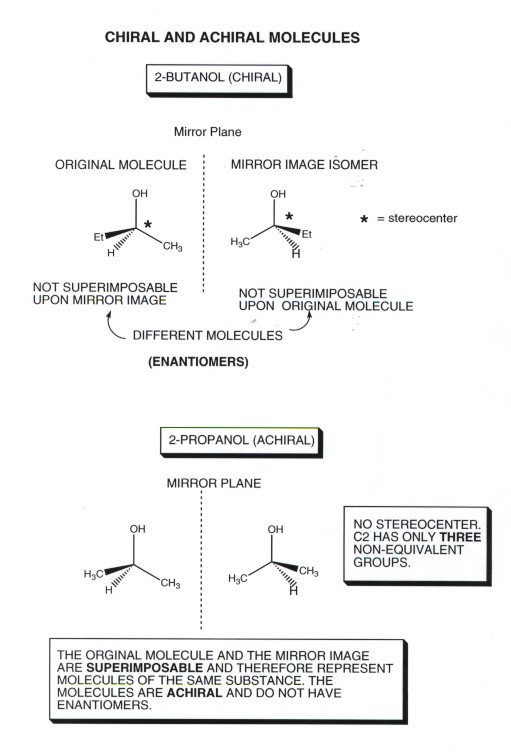
Symmetry Elements Which Guarantee Achirality
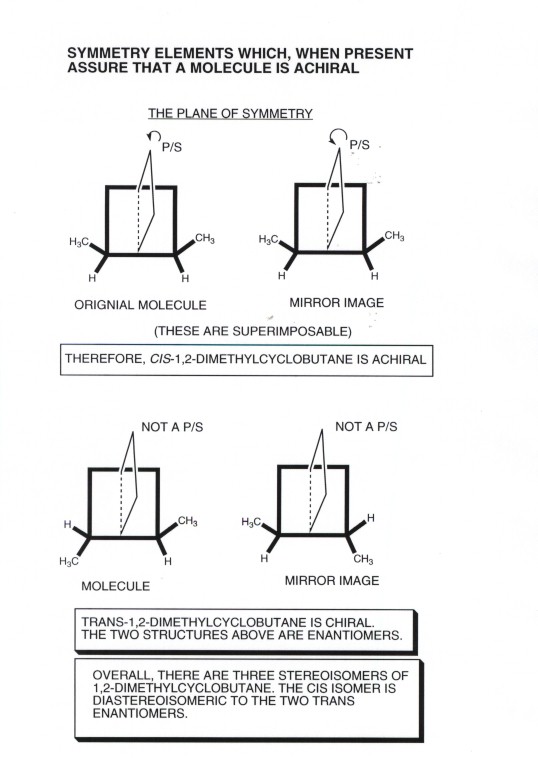
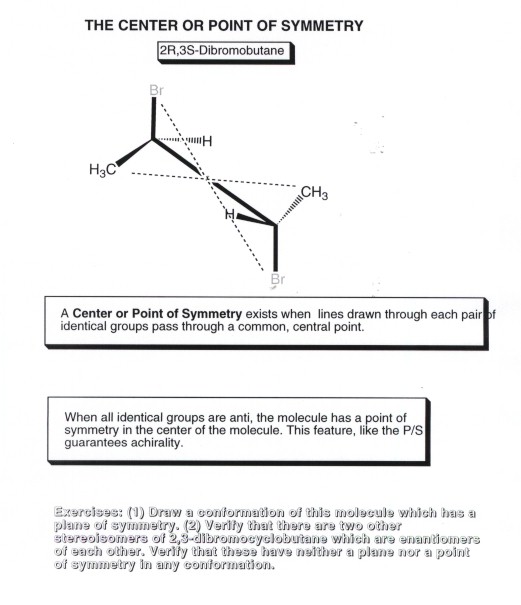
R,S Nomenclature
NAMING ENANTIOMERS
Since two enantiomers are different compounds, we will need to take classification which distinguishes them from each other. The convention which is used is called the (R,Southward) organisation because one enantiomer is assinged as the R enantiomer and the other equally the S enantiomer. What are the rules which govern which is which??
- Priorities are assigned to each of the four dissimilar groups attached to a given stereogenic centre (one through four, one being the grouping of highest priority). (It should be understood that each stereogenic center has to be treated separately.)
- Orient the molecule so that the group of priority four (lowest priority) points away from the observer.
- Draw a round arrow from the group of commencement priority to the group of second priority.
- If this circular motility is clockwise, the enantiomer is the R enantiomer. If it is counterclockwise, it is the Due south enantiomer.
HOW TO ASSIGN GROUP PRIORITIES
There is also a set of conventions (rules) which govern the setting of group priorities, which is a part of the R,Southward arrangement of nomenclature.
- Priority is based upon atomic number, i.due east., H has the lowest priority, O over C, F over O, and so on. Priority assignment is based upon the four atoms direct fastened to the stereogenic center. For example, in 2-butanol, the example we considered previously, the four atoms are H,O, and two C's. Oxygen gets the first priority, and H the 4th. But the methyl and ethyl groups both are fastened through carbon , then there is initially a tie for the second and third priorities.
- In this kind of tie state of affairs, priority assignments proceed outward to the next atoms, which we will call the beta atoms.(The directly attached atoms are the alpha atoms). For the methyl group, the blastoff atom is carbon and the beta atoms are three H's, while for the ethyl group the alpha cantlet is besides carbon and the beta atoms are 2 H'southward and 1 carbon. This beta C of the ethyl group wins the priority contest because there is no beta atom on the methyl grouping which has an atomic number greater than i (all three beta atoms are H). In general, the competition contines from alpha to beta to gamma to delta atoms until a tie-breaker is found.
- Some additional conventions are necessary for treatment multiple bonds and aromatic bonds, and these are a little tricky to learn. As an case, take the vinyl group. Each carbon of this double bond is considered to have two bonds to carbon, considering of the double bond. In the case of a carbonyl grouping, the carbon is considered to be bonded to 2 oxygens, and the oxygen is considered to exist bonded to two carbons. For this reason, a vinyl grouping has priority over an isopropyl group, every bit shown in the illustration.

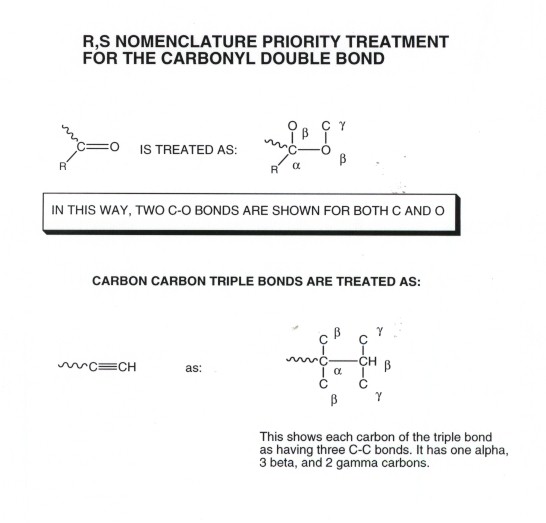
Two Stereogenic Centers
Non-Equivalent Stereogenic Centers
- When a molecule has two stereogenic centers, each of them can exist designated equally R or Due south. Thus in that location are iv possible stereoisomers. If we designate one stereocenter as "a" and the other as "b" only for labelling purposes, the four stereoisomers tin can be designated as RaRb,RaSb,SaRb, and SaSb These designations correspond to the cirucumstance theat stereocenter "a" tin can have the R or South configuration ,and stereocenter "b" can have either configuration.
- In general, if in that location are n such stereogenic centers , there will be a maximum of 2north stereoisomers. For example, with three stereogenic centers, at that place are eight possible stereoisomers. The maximum of 2north occurs when there are all non-equivalent stereocenters. Stereogenic centers are equivalent when all four substituents fastened to the center are identical. For example, in 2,3-dibromobutane, both stereogenic carbons take a H, a Br, a methyl, and a 1-bromoethyl substituent. The maximum of four stereoisomers is non observed here, equally we saw before. In fact there are 3 stereoisomers, including ane achiral stereoisomer. This is because the 2R,3S molecule is identical to the 2S,3R molecule, since carbons ii and iii are equivalent.
- On the other hand, 2,iii-dibromopentane has two not-equivalent stereogenic centers and in that location are four stereoisomers, consisting of 2 pairs of enantiomers. It should exist noted that the relationship between one enantiomeric pair and the other pair of enantiomers is that they are diastereoisomers..
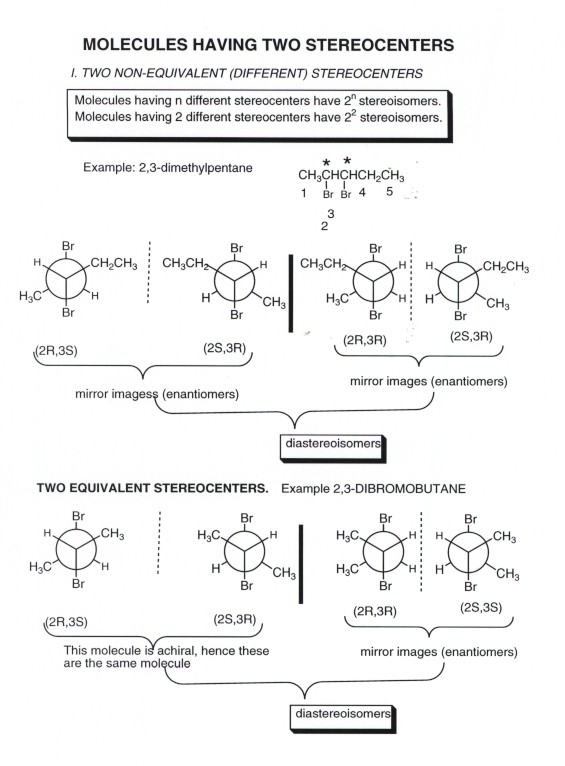
TWO EQUIVALENT STEREOGENIC CENTERS
- As noted above, when both stereogenic centers are equivalent, the number of stereoisomers is less than the maximum of 2due north, only in fact is northward + 1. In the case of 2 stereogenic centers (due north = ii), there are 3 stereoisomers, as we saw for 2,iii-dibromobutane. There is, offset of all , a pair of enantiomeers: these are the (2R,3R) and (2S,3S) isomers. Note that the mirror image of 2R,3R is 2S,3S ( i.e., the mirror image inverts the configuration at each stereocenter).
- In that location is also an achiral stereoisomer. A molecule which has stereocenters simply is achiral is called a meso compound. Nosotros saw in an earlier diagram that this molecule has a betoken of symmetry in its most stable conformation.
- Information technology should be noted carefully that the meso isomer is a diastereoisomer of the ii enantiomers.
COMPARATIVE PROPERTIES OF ENANTIOMERS AND DIASTEREOISOMERS
DIASTEREOISOMERS
- Diastereoisomers are not mirror image isomers. They are essentially like any other pair of isomers (e.yard., constitutional isomers) in that they have distinct chemical and physical properties. Since they have the aforementioned functional groups, however, they are usually rather like to one another in their reactions and properties.
- Two diastereoisomers can unremarkably be separated from ane another by , e.yard., recrystallization, since they have different solubilities.
- Although their chemical backdrop(reactions) are similar, the two diastereoisomers will typically react at unlike rates.
ENANTIOMERS
- Since two enantiomers are mirror images of each other, they are not distinguished by any physical or chemic means which cannot distinguish mirror images, i.east., which are non themselves chiral (handed, pregnant can distinguish left from right).
- Therefore 2 enantiomers accept exactly the aforementioned free energy, solubility in typical achiral solvents, humid and melting points, NMR and IR spectra, etc.
- Their chemical properties, including both the qualitative reactions and the quantitative rates of reaction are identical when reacting with achiral chemical species.
- In full general, then, both chemical and physical backdrop of 2 enantiomers are exactly identical twoard achiral agents,chemic or physical. ,li>It is of import to realize, all the same, that when 2 enantiome4s react with a pure single enantiomer of another chiral compound, the rates of reaction of the 2 enantiomers volition be different (more afterward).
- Likewise, i concrete property which tin distinguish them is "optical activity" (see below).
OPTICAL ACTIVITY
- Since enantiomers are "handed" or "chiral", they can be distinguished past other agents which are chiral. Thus, we can hands tell, in using our correct paw to milkshake hands with another person, whether that person is using his left or right manus. There is a improve "fit" of the two right hands than there is of right hand to left mitt.
- Chemically this occurs, as noted above, when enantiomers react with another chiral chemical compound. Both the original enantiomer and its reactant distinguish left from right , and then and so one of the original enantiomers volition find a better energetic fit with the chiral compound than will the other.
- One concrete belongings which distinguishes two enantiomers is "optical activeness". This term refers to the property of chiral compounds (exclusively) of rotating the plane of plane-polarized low-cal to the right (clockwise) or to the left (counterclockwise).
- The two enantiomers have exactly the same ability to rotate this plane, quantitatively, but they rotate information technology in opposite senses. Thus, if one enantiomer rotates the plane past 10.5 degrees clockwise (considered a positive rotation), the other rotates it by -x.5 degrees (i.due east., in the counterclockwise direction).
- Since the exact amount of the rotation of the aeroplane by a given enantiomer depends upon how much of that enentiomer the lite encounters as it passes through the solution, the measured rotation is divided past the concentration of the enantiomer and by the path length of the polarimeter cell to give a true measure out of the inherent power of the enantiomer to rotate the aeroplane of polarized calorie-free. This number is called the specific rotation. Note that in deriving the specific rotation, the concentration is taken in grams per mL, and the path length in decimeters. The magnitude of the rotation also depends upon the wave length of the plane polarized light, and then the a single moving ridge length is usually used, i.e., the sodium D line (529 nm),the line responsible for the yellow colour of sodium-vapor lamps.
- A positive (clockwise) rotation is sometimes called dextrorotation and a ngetaive rotation is sometimes called levorotation
RACEMIC MIXTURES
- A racemic mixture is a fifty:l mixture of the 2 enantiomers of a chiral chemical compound.
- Because the two enantiomers take equal and reverse specific rotations, a racemic mixture has a specific rotation of null, i.e., it is optically inactive
- In nature, virtually naturally occurring compounds occur as a unmarried enantiomer, not as racemic mixtures. The importance of racemic mixtures is that ordinary laboratory synthesis which generate a stereogenic center produce a racemic mixture. For example,if 1-butene is converted to ii-butanol by the addition of water catalyzed past acid, a stereogenic center is created in a molecule where none previously existed. Since both enantiomers have equal energy, and since there is nothing in the goad or solvent or reactant that is chiral, both enantiomers are formed in equal amounts(for a mechanistic explanation, run into subsequently).
- Whereas racemic mixtures are not peculiarly desirable, they are not problematic in many labaoratory organic syntheses. Nonetheless, in the manufacture of drugs, ordinarily only a single enantiomer is constructive, so that it is desirable to synthesize only a single enaniomer. Withal, racemic drugs are ofttimes used anyhow because the other enaniomer is harmless, and racemic mixtrues are easier(read, cheaper) to synthesize.
OPTICAL PURITY
- If the specific rotation of a pure single enantiomer is known, it is easy to determine the purity of a sample containing both enantiomers in unequal amounts. The %OPTICAL PURITY = specific rotation of the sample/specific rotation of the pure enantiomer. This item measure of optical purity is often called ENANTIOMERIC Backlog( or ee) considering it gives %R - %South. A small trouble (admittedly very modest, mathematically) arises in converted the ee (enantiomeric excess) into a specific composition given in terms of %R and %S. I simple way of doing this is as follows: If the enantiomeric excess of the R enantiomer is, for example, lxxx%, this means that in that location is 80% of the R enantiomer plus 20% of the racemic mixture (non 20%South). Since the racemic mixture is 10%R and ten%S, the composition of the mixture is ninety% R and 10%S. Remember: ee represents not the % of one of the enantiomers, but the difference between the % of one pure enaniomer and the % of racemic mixture).
SEPARATION OF ENANTIOMERS
- The separation of 2 enantiomers present in a racemic mixture or whatsoever mixture of enantiomers, is called resolution .
- Enantiomers are not readily separated past conventional means, such as recrystallization or fractional distillation, since they have the same solubilities, thousand.p.'southward, b.p.'southward, etc. Then, special means are required for "resolution" of ii enantiomers.
- One common strategy for resolution is oftentimes to take reward of the circumstance that, while enatiomers have the same solubilities and cannot exist readily separated past simple recrystallization, diastereoisomers have different solubilites. The two enantiomers present in a racemic mixtrue can exist reacted with a pure enantiomer of a chiral chemical compound (chosen a resolving agent) which nosotros accept on hand (many occur in pure form in nature). This will form a compound with two chiral centers, and volition give ascension to 2 different diastereoisomers which can be separated from each other. Post-obit this separation the chiral resolving agent rcan be removed by through some chemical reaction to requite the two divide enantiomers. The chiral resolving agentcan also be recovered for re-use.
- Every bit an example, consider the generalized case shown in the illustration below.
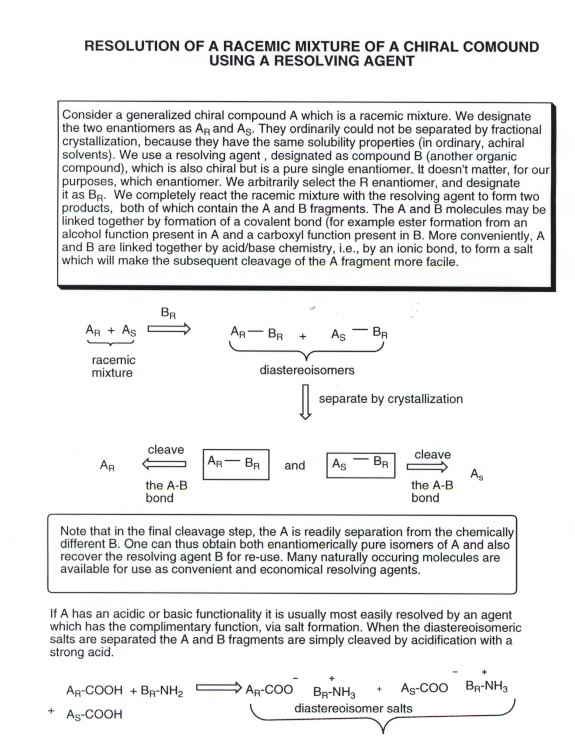
KINETIC RESOLUTION USING ENZYMES
- Enzymes are proteins which have many chiral centers and which occur in nature as a single enantiomer (out of all the myriads of possible stereoisomers).
- The rates of reaction of 2 enantiomers with a single enantiomer of any chiral substance are different. We tin see that the products will be diastereoisomeric, and then of different energies, and the rates of germination of these products volition in general exist different. In other words, a "handed" molecule can distinguish chemically between 2 mirror image isomers. Enzymes are peculiarly effective in making this stardom, so that a racemic mixture can oft be hands resolved past reaction with some simple substance in the presence of the chiral enzyme equally catalyst. The enantiomer whiich reacts faster will exist converted to a new chemical compound having an entirely different functional group, while the enantiomer which reacts more slowly volition remain unreacted. The separation of the 2 compounds is and so quite easy.
- As an instance, if the compound which is the racemic mixture has an alochol function, it tin exist converted to an acetate ester by reaction with acerb acid in the presence of a suitable esterifying enzyme. The separation of the ester of i enantiomer from the alcohol of the other is so very piece of cake. Then ester can and so exist hydrolyzed to the alcohol, if desired, past either simple chemical means or by enzyme catalyzed reaction.
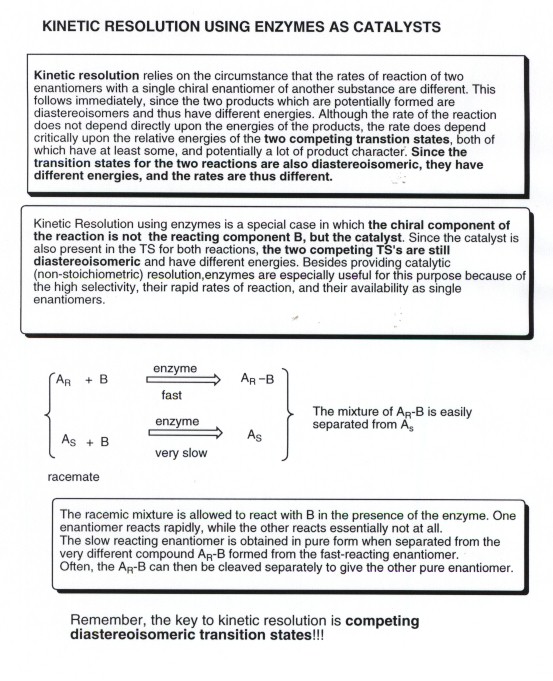
RETURN TO THE Acme OF THIS Folio
ON TO THE Next Chapter:ALKENES I
BACK TO THE PREVIOUS CHAPTER
BACK TO THE BAULD HOME Page
Source: https://research.cm.utexas.edu/nbauld/teach/stereo.html
Posted by: laracoble1939.blogspot.com


0 Response to "How To Draw 1 4-dimethyl-1 Pentene"
Post a Comment